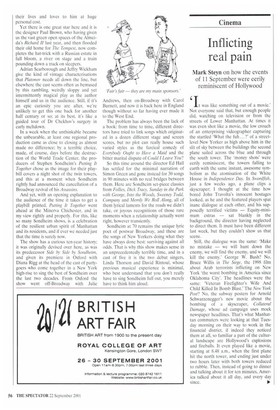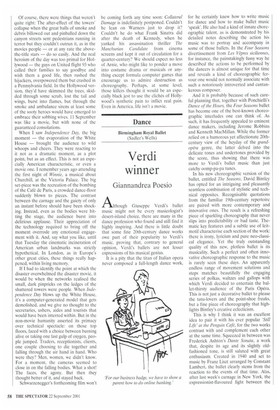Cinema
Inflicting real pain
Mark Steyn on how the events of 11 September were eerily reminiscent of Hollywood
g It was like something out of a movie.' Not everyone said that, but enough people did, watching on television or from the streets of Lower Manhattan. At times it was even shot like a movie, the low crouch of an enterprising videographer capturing the startled 'What the fuh ... T of a streetlevel New Yorker as high above him in the slit of sky between the buildings the second plane sailed across the blue and through the south tower. The 'money shots' were eerily reminiscent, the towers falling to earth with the same instant, awesome symbolism as the atomisation of the White House in Independence Day. In Swordfish, just a few weeks ago, a plane clips a skyscraper; I thought at the time how bored John Travolta's innocent hostages looked, as he and the featured players spat inane dialogue at each other, and his supposedly terrified victims — Equity-minimum extras — sat blankly in the background, the director having neglected to direct them. It must have been different last week, but they couldn't show us that scene.
Still, the dialogue was the same: 'Make no mistake — we will hunt down the enemy, we will find the enemy, and we will kill the enemy.' George W. Bush? No, Bruce Willis in The Siege, the 1998 film about Arab terrorists inflicting on New York 'the worst bombing in America since Oklahoma City'. The headlines were the same: 'Veteran Firefighter's Wife And Child Killed In Bomb Blast.' The New York Post? No, the subway posters for Arnold Schwarzenegger's new movie about the bombing of a skyscraper, Collateral Damage, whose ad campaign uses mock newspaper headlines. That's what Manhattan commuters were looking at that Tuesday morning on their way to work in the financial district, if indeed they noticed them at all, so familiar a part of the cultural landscape are Hollywood's explosions and fireballs. It even played like a movie, starting at 8.48 a.m., when the first plane hit the north tower, and ending just under two hours later with both towers reduced to rubble. Then, instead of going to dinner and talking about it for ten minutes, America talked about it all day, and every day since. •
Of course, there were things that weren't quite right: The after-effect of the towers' collapse when the great balls of smoke and debris billowed out and pinballed down the canyon streets sent pedestrians running in terror but they couldn't outrun it, as in the movies people — or at any rate the abovethe-title stars — do so easily. And the real heroism of the day was too primal for Hollywood — the guys on United flight 93 who called their families to say goodbye and wish them a good life, then rushed the hijackers, overpowered them but crashed in a Pennsylvania field. In the Hollywood version, they'd have skimmed the trees, skidded through some scrub, lost the tail and wings, burst into flames, but through the smoke and ambulance sirens at least some of the sooty heroes would have emerged to embrace their sobbing wives. 11 September was like a movie, but with none of the guaranteed consolations.
When I saw Independence Day, the big moment — the evaporation of the White House — brought the audience to wild whoops and cheers. They were reacting to it not as a dramatic moment, as a plot point, but as an effect. This is not an especially American characteristic, or even a movie one. I remember years ago attending the first night of Winnie, a musical about Churchill, at the Victoria Palace. The big set-piece was the recreation of the bombing of the Café de Paris, a crowded dance-floor suddenly blown to pieces. The contrast between the carnage and the gaiety of only an instant before should have been shocking. Instead, even as the bodies were hitting the stage, the audience burst into delirious applause. Their appreciation of the technology required to bring off the moment overrode any emotional engagement with it. And, say what you like, until that Tuesday the cinematic incineration of American urban landmarks was strictly hypothetical. In London, as in Europe's other great cities, these things really happened, within living memory.
III had to identify the point at which the disaster overwhelmed the disaster movie, it would be when the networks realised the small, dark pinpricks on the ledges of the shattered towers were people. When Independence Day blows up the White House, it's a computer-generated model that gets demolished, and we give no thought to the secretaries, ushers, aides and tourists that would have been interred within. But in the non-movie humanity asserted its primacy over technical spectacle: on those top floors, faced with a choice between burning alive or taking one last gulp of oxygen, people jumped. Traders, receptionists, clients, one couple choosing to die together and falling through the air hand in hand. Who were they? Men, women, we didn't know. For a moment, the cameras seemed to close in on the falling bodies. What a shot! The faces, the agony. But then they thought better of it, and stayed back.
Schwarzenegger's forthcoming film won't be coming forth any time soon: Collateral Damage is indefinitely postponed. Couldn't he lean on Warners just to drop it? Couldn't he do what Frank Sinatra did after the death of Kennedy, when he yanked his assassination thriller The Manchurian Candidate from cinema screens and kept it out of circulation for a quarter-century? We should expect no less of Arnie, who might like to ponder a move into costume drama or musicals or anything except formula computer games that encourage us to admire destruction as choreography. Perhaps, at some level, those killers thought it would be an especially black jest to use the clichés of Hollywood's synthetic pain to inflict real pain. Even in America, life isn't a movie.











































































 Previous page
Previous page